Red Nickel Scale Model
| Language |
|
|---|
Provided by Solar System Ambassador Kevin Sullivan (November 2011):
This is my favorite scale model activity, which I have been doing for about 8 years for the 8th grade physical science class at Diablo View Middle School in Clayton, CA.
Materials:
- 1 quarter, painted blue
- 1 nickel, painted red
- 1 dime
I use this as an introductory lecture, to acquaint students with where things are in space. Help them to understand "why we don't fly the space shuttle to a black hole" kind of questions. I have a lot of fun hamming this up as an icebreaker for the three separate space exploration lectures I give.
I break up space mentally for them into the earth/moon system (where people have gone), the solar system (where probes have gone) and deep space (which we can only see through telescopes). This is the foundation exercise of the first lecture:
I ask for three volunteers "for a paying job."
The first student holds up the quarter, which is Earth. I joke that if they drop it, there will be earthquakes. Talk about how everything in their world - parents, teachers, friends, pets, iPhones, and the San Francisco 49ers - is now shrunk down to the size of a quarter. Show that the height of the ISS is roughly the height of the ridges on the quarter. It's in space but it's near-earth orbit. Emphasize that of all the astronauts there have been to space in the last 50 years, most have only been this high above the ground. That's closer than when we drive from San Francisco to Lake Tahoe...but there still in microgravity, it's still a huge challenge, you can still get hurt in a hurry if something goes wrong, etc.
Now, second student holds up the dime - the moon - it's silvery grey. Push them together so the earth and the moon almost touch. Have the students guess how far away the moon is - make a game of it. The correct answer is about 3 feet. Now with my hands I map out the Apollo missions from the quarter to the dime and back, emphasizing that only nine groups of three men have ever traveled this far from the home planet. Three days out, a day or so there, three days back - a week to 10 day trip. But it took all of America working for 10 years from JFK to Armstrong to get this done - a huge technical challenge.
We talk that the moon controls tides on earth, so if they drop the moon, they'll be a tsunami. Be careful!
The last student holds up Mars - now the fun begins. I set Mars the same distance (3 feet) past the moon. Ask the students if that feels about right. Most will say yes. One may think it's farther. Ask him how much farther he thinks it should be. I double the distance to six feet - take a vote "how many people think nearer? How many farther? How many say just right?" Double the distance again. Same vote. Go across the entire room - another vote. Have the student go out the door (at our school they can't walk on the grass, but I say they are allowed to since it's a science experiment) - vote again. I finally ask the class if I should send the student across the street, down the hill, and over to a park? They need to go about ~500 feet away.
Then...drumroll.....I ask them if anyone shoots targets. I ask them if the could hit a nickel at 500 feet (most say the couldn't), but could they have the point of a bullet hit Jefferson's eye at 500 feet. That's what the amazing folks at the Jet Propulsion Laboratory did with the Mars Exploration Rovers. These guys rocked the target practice range. Landed them right where they targeted, that far way. Oh, and did I mention the nickel was spinning while they did it? Heckuva shot, isn't it? Usually the wow'sare coming fast and furious.
But....we haven't figured out how to get people out there yet......that's going to be the job of the people in this room. I'm looking forward to seeing how you all figure that out.
Call the students back together. Good sport student who was Mars gets to pick one of the planets as payment. Sometimes they'll take the quarter, but usually they've gotten attached to Mars by then.
I then segue into a thought trip where we drive a minivan at highway speed to a few places. It takes six months to 'drive' to the moon at minivan speeds (imagine spending six months in a minivan with your family!). Apollo took 3 days.
Going more quickly (like at the speed of light) it takes 1.5 seconds. (You can hear that delay in the Apollo moon mission voice transmissions - so we've tested the speed of light via radio from the earth to the moon) Use that as a jumping off point for planetary and interstellar distances.
I use two slides (Distance Slides (Power Point, 476 KB)) that we walk through. During the beam at the speed of lightslide I start to bring out the idea of time delay in light arriving - the Sun we see is the sun of 8 minutes ago; the light from the closest star left that star when you were in third grade, the light from the farthest star you can see left during the time of the Romans...and then we make the jump to light form before there were humans, before there was earth, etc.
Fun, fun stuff. I look forward to this lecture every year - the kids get the scale of the universe in a gut level way. I refer back to this framework in later lectures to reorient them.
I do seven classes a year for about eight years - so there are about 50 blue quarters out there. Last year, I had a student bring me one she had gotten as change - she had kept it as good luck. :-)



























